BLEACHING WITH RESTORATIVE TREATMENT
While bleaching of discolored teeth usually provides significant improvement to a smile, in some cases additional restorative treatments may be indicated to achieve the desired esthetic result. In addition, there are many cases in which a patient presents with existing restorations that need to be replaced for functional reasons or that do not match the natural dentition. It is important to discuss all possible treatment options with the patient during the planning stages and to conduct a thorough smile analysis and bleaching examination. Patients should be aware of the possibilities and limitations associated with bleaching and other proposed procedures, such as esthetic recontouring, microabrasion, macroabrasion, bonded composite restorations, composite or porcelain veneers, and all-ceramic or porcelain-fused-to-metal crowns, used alone or in combination. In nearly every case, it is advantageous to perform bleaching before any other treatments because (1) it is the least invasive option and may provide sufficiently pleasing results, precluding the need for further treatment, and (2) the lighter shade of the teeth allows for the placement of more esthetic restorations.
When Bleaching Is Not Enough
Sometimes bleaching is successful but the patient is still unhappy with the shape of the teeth. In these cases, it is best to bleach first, then follow with esthetic recontouring or restorative treatment.
Bleaching in conjunction with esthetic recontouring requires knowledge of esthetic principles, which include the appropriate location of the incisal edges of the anterior teeth, the location of the gingival contours of the teeth, and the proper tooth shapes as defined by the line angles. Additionally, understanding of occlusion is essential, since alteration of the anterior teeth can potentially alter anterior guidance. Although recontouring is a subtractive treatment, involving the removal of tooth structure, bleaching combined with recontouring remains the simplest and most long-lasting treatment option.
In some cases, the tooth form requires additive (ie, restorative) treatment if an esthetic smile is to be achieved. Once the teeth have been bleached to the desired color, a matching shade can be chosen for the restoration, whether it may be composite bonding, a veneer, or a crown.
Unsuccessful Bleaching Therapy
When stains are not responsive to bleaching, they have to be either removed by abrasion or masked by a restoration. The patient should be informed up front regarding the treatment options and the different fees for each procedure.
The first option would be to remove the staining using either microabrasion or macroabrasion. Microabrasion involves the softening of the surface of enamel by a mild acid and the subsequent removal of the enamel by abrasion with pumice. Macroabrasion involves the use of a high-speed handpiece and finishing diamonds or carbide burs, followed by disk and paste polishing.
Superficial discolorations can usually be removed from the enamel surface; however, it is impossible to know in advance whether the discoloration is superficial. Should the discoloration extend to the dentin or become more visible following abrasion, a resin composite restoration will need to be placed to seal the defect and restore contour. Unless the tooth enamel is of a chalky texture, it is best to bleach teeth prior to initiating abrasive techniques to establish the tooth shade, should a resin composite restoration be required.
If additions to the tooth shape and form are needed, or if discolorations must be masked, then bonding of composite restorations is an excellent option. The tooth is first bleached to either its maximum whiteness or to the shade with which the patient is most comfortable. Often the bleaching makes the teeth light enough that composite restorations can hide the remaining discoloration and complete the tooth shape successfully. Restorative treatment should be delayed for 2 weeks after cessation of bleaching to allow the tooth to achieve a stable shade and the bond strengths to return to normal. It has been shown that there is a 25% reduction in bond strengths of etched enamel to composite materials if the restoration is placed immediately after bleaching.
Bleaching and bonding offer a very conservative approach to management of discolored and malformed teeth. A combination of conservative treatments is most cost effective and preserves the natural enamel of the tooth. However, should bleaching, abrasion, and bonding not provide the desired esthetic outcome, other restorative options (ie, composite or porcelain veneers and all-ceramic or porcelain-fused-to-metal crowns) are still available.
A composite or ceramic veneer may be placed on discolored teeth to cover the underlying stain. However, the natural appearance of the veneered surface depends strongly upon the transmission and reflection of light from the underlying tooth structure. If the tooth structure is stained too darkly, the discoloration will show through a translucent resin composite or ceramic veneer. The only solution is to make the veneering material thicker and less translucent, and therefore less lifelike. Moreover, it is necessary to remove more of the facial and proximal tooth structure to achieve the esthetic and functional objectives. Bleaching therapy prior to veneer placement decreases the need for a thicker veneer and more tooth reduction.
In some cases, only placement of a crown will adequately restore esthetics and function. In these situations, bleaching prior to restorative treatment is still the best approach, since the surrounding dentition will have a lighter and more esthetic shade to which the crown or crowns can be matched.
Bleaching Restored Teeth
Bleaching will not change the color of existing restorations. Therefore, during the bleaching analysis, the clinician should identify any existing restorations that show in the widest smile and inform patients of the additional fee associated with replacing any restorations that do not match the teeth after bleaching. Occasionally the existing restoration will match well enough after bleaching to be acceptable to the patient, or it may be that the restorations originally matched the teeth, but the teeth darkened with age. In the latter case, bleaching may restore the teeth to the original shade of the restoration, and additional restorative treatment may not be required. In the case of composite bonding and veneers, the shade of the underlying tooth material can be changed from the lingual aspect, which sometimes gives the veneers a lighter appearance. Also, over time, veneers may acquire stains at the margins. Bleaching can also be used to remove these stains prior to resealing the margins with a dentin bonding agent. Occasionally, there are also cases in which conservative restorations can be removed, and bleaching can be performed to achieve an acceptable esthetic result without replacement of the restorations. However, this is only possible if there has been minimal to no reduction of the tooth structure.
CASE 1 Bleaching followed by composite bonding
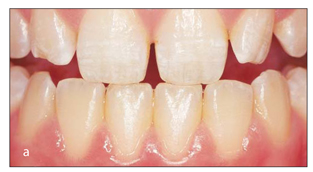
A smile analysis reveals the need for bleaching and composite bonding.
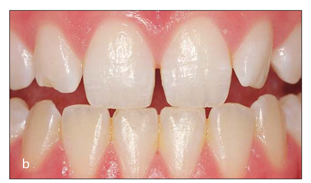
Two weeks after bleaching the shade has stabilized and bond strengths have returned to normal.
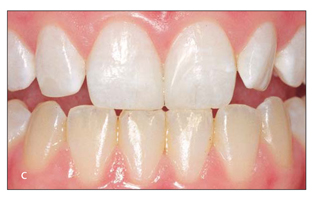
No preparation other than cleaning the enamel, etching, and bonding was required prior to bonding. This noninvasive, conservative approach provides a good esthetic outcome in terms of both shade and shape.
CASES 2 TO 9 Bleaching teeth with existing composite restorations
Although bleaching with existing composite restorations in place is recommended, it is important that the patient understand that the composite will not change color with bleaching. Some surface staining may be removed, but the basic color of the composite remains the same. Patients often expect bleaching to eliminate any discolorations on their teeth or may think that the discolored composite is actually part of the tooth. Therefore, it is important that the restorations be identified in the bleaching analysis, especially since discolored restorations may actually be more noticeable when the teeth are lightened. Patients need to be made aware of their existing restorations, as well as their financial responsibility should the restorations need to be replaced after bleaching. Even when replacement of composite restorations is planned, it is preferable to bleach the teeth with the restorations in place to best maintain esthetics and function during treatment and to determine the optimal shade for the new restorations.
CASE 2
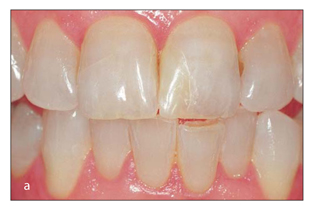
In the preoperative view, the composite restorations are subtle but visible, especially the restoration on the mesial aspect of the maxillary left lateral incisor.
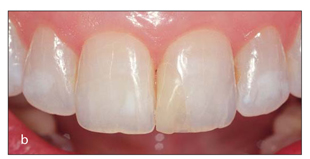
After bleaching, the appearance is improved, but the composite restorations are still discolored. The patient was aware of the possible need for replacement of the composite restorations prior to initiation of bleaching treatment.
CASE 3
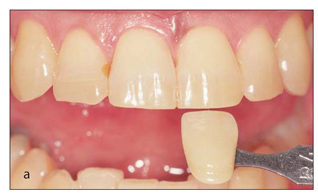
During the bleaching analysis, the old chemical-cured type of composite was identified on the mesial aspect of the maxillary right lateral incisor.
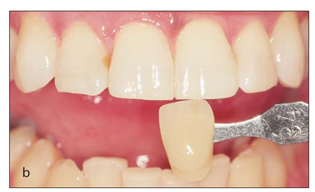
After bleaching, the composite restoration is much more noticeable. The patient ultimately decided to have that restoration replaced to better match the lighter teeth.
CASE 4
Stay updated, free dental videos. Join our Telegram channel

VIDEdental - Online dental courses



